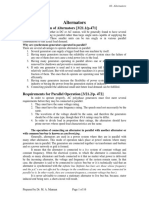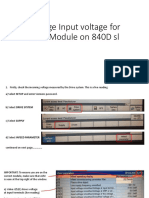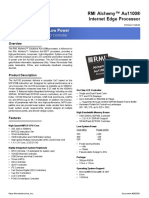0 ratings0% found this document useful (0 votes)
27 viewsIsrael A. Funa November 20, 2017 EE-4B
Israel A. Funa November 20, 2017 EE-4B
Uploaded by
israeljumbo1. Parallel operation of transformers is more economical than using a single larger transformer when higher power is needed, as it maximizes efficiency, availability, reliability, and flexibility of the electrical power system.
2. For transformers to operate in parallel, their voltage ratings, transformation ratios, polarities, and impedances must match. Their primary windings must also be suitable for the supply voltage and frequency.
3. Under no load and load conditions, parallel transformers will share current loads based on their impedance ratios and transformation ratios. Unequal ratios can cause circulating currents that reduce efficiency. Proper design is needed for reliable parallel operation.
Copyright:
© All Rights Reserved
Available Formats
Download as DOCX, PDF, TXT or read online from Scribd
Israel A. Funa November 20, 2017 EE-4B
Israel A. Funa November 20, 2017 EE-4B
Uploaded by
israeljumbo0 ratings0% found this document useful (0 votes)
27 views5 pages1. Parallel operation of transformers is more economical than using a single larger transformer when higher power is needed, as it maximizes efficiency, availability, reliability, and flexibility of the electrical power system.
2. For transformers to operate in parallel, their voltage ratings, transformation ratios, polarities, and impedances must match. Their primary windings must also be suitable for the supply voltage and frequency.
3. Under no load and load conditions, parallel transformers will share current loads based on their impedance ratios and transformation ratios. Unequal ratios can cause circulating currents that reduce efficiency. Proper design is needed for reliable parallel operation.
Original Description:
Report about
Original Title
Transformer
Copyright
© © All Rights Reserved
Available Formats
DOCX, PDF, TXT or read online from Scribd
Share this document
Did you find this document useful?
Is this content inappropriate?
1. Parallel operation of transformers is more economical than using a single larger transformer when higher power is needed, as it maximizes efficiency, availability, reliability, and flexibility of the electrical power system.
2. For transformers to operate in parallel, their voltage ratings, transformation ratios, polarities, and impedances must match. Their primary windings must also be suitable for the supply voltage and frequency.
3. Under no load and load conditions, parallel transformers will share current loads based on their impedance ratios and transformation ratios. Unequal ratios can cause circulating currents that reduce efficiency. Proper design is needed for reliable parallel operation.
Copyright:
© All Rights Reserved
Available Formats
Download as DOCX, PDF, TXT or read online from Scribd
Download as docx, pdf, or txt
0 ratings0% found this document useful (0 votes)
27 views5 pagesIsrael A. Funa November 20, 2017 EE-4B
Israel A. Funa November 20, 2017 EE-4B
Uploaded by
israeljumbo1. Parallel operation of transformers is more economical than using a single larger transformer when higher power is needed, as it maximizes efficiency, availability, reliability, and flexibility of the electrical power system.
2. For transformers to operate in parallel, their voltage ratings, transformation ratios, polarities, and impedances must match. Their primary windings must also be suitable for the supply voltage and frequency.
3. Under no load and load conditions, parallel transformers will share current loads based on their impedance ratios and transformation ratios. Unequal ratios can cause circulating currents that reduce efficiency. Proper design is needed for reliable parallel operation.
Copyright:
© All Rights Reserved
Available Formats
Download as DOCX, PDF, TXT or read online from Scribd
Download as docx, pdf, or txt
You are on page 1of 5
Israel A.
Funa November
20, 2017
EE-4B
Parallel operation of Transformers
In the previous lesson we discussed about the operation, applications,
and principles of transformers. Now we will discuss a more complicated
operation of transformers which is parallel operation of transformers.
Operation of transformers in parallel is more economical than building
bigger transformers, when higher rating of voltages and current is needed to
be transformed. There are also several advantages when of parallel
operation over building bigger transformers, these are; maximizing
electrical power system efficiency, maximizing electrical power system
availability, maximizing electrical power system reliability, and maximizing
electrical power system flexibility. Why it maximizes the electrical power
system efficiency? In operation of transformers, we can see that maximum
efficiency occurs when in full load or near full load, (copper and iron loss
must be equal). So when a certain load is needed we can choose a
transformer which will operate in full load to maximize the efficiency. And
when another certain load is added or introduced to the system, we can add
another transformer. if that load is operated with a bigger transformer, the
efficiency will not be as good as paralleling transformers. Why it maximizes
electrical power system availability? In a situation, where one transformer
needs maintenance, we can switch a spare of transformer without
interrupting the transformer. If a single bigger transformer needs a
maintenance, electrical power system will be interrupted because no
transformer will operate while switching a spare. Why it maximizes
electrical power system reliability? If one transformer breaks or tripped,
other transformers will share the load hence the supply will not be
interrupted. Why it maximizes power system flexibility? In the future,
expansion will not be a problem. When there is an increase in load, we can
parallel another transformer to prevent other transformers from
overloading.
We discussed the advantages of paralleling transformers and now we
will discuss conditions for parallel operation of transformers. The
conditions are;
1. The voltage ratings of both primaries and secondaries must be
identical. This obviously implies that the transformation ratios are
the same.
2. The transformers must be properly connected with regard to
polarity.
3. The equivalent impedances should be inversely proportional to the
respective kilovolt-ampere ratings.
4. The ratio of the equivalent resistance to the equivalent reactance of
all transformers should be the same
5. Primary windings of the transformer should be suitable for the
supply system voltage and frequency.
If the voltage ratings of both primaries and secondaries must be
identical is not met, it is possible to have parallel operation but there will be
circulating current even in no load operations. And if there are circulating
currents in secondary there are also circulating currents in primary
windings. Also when it is loaded, they will produce unequal loading that will
lead to one transformer to overload.
If the ratio of the equivalent resistance to the equivalent reactance of
all transformers are not the same, parallel operation will still be possible.
But with different power factor they will not share the same load in
proportion to their kva ratings.
If the transformers are connected without the regards to the polarity
It will result in dead short circuit. But we can connect transformers in two
ways with regards to the polarity, we can connect it with same polarities
and also we can connect it with reverse polarities. It depends on what is
your purpose. Also if the primary windings of the transformer are not
suitable for the supply system voltage and frequency, it will neither work
nor operate. If it operates, it will shorten the lifespan of the transformer and
also this is very dangerous because it will be a fire hazard.
In parallel operation of transformers, we have no load operation and load
operation (equal ratios of transformation and unequal ratios of transformation).
In no load operation, the load is open or have infinity resistance, but primary
winding is still energized and the secondaries will remain connected in parallel. In
no load operation the secondaries will have no current when the ratio of
transformation of the two transformers are ezactly equal, but when the ratio of
the transformer 1 is different from transformer 2, there will be circulating current
in secondary Ic, and the current circulating is computed with the formula
In load operation when two transformers have equal turns ratio they will
share the current of the load. But these sharing is not equally shared if the
equivalent impedances are not equal. The relation of current and equivalent
impedances are inversely proportional to each other.
In cases with load operation when two transformers have different or
unequal ratio of transformation are connected in parallel, the total load current
will divide in accordance to the formula given below. Note that the total load does
not divide inversely as the transformer impedances when the transformer ratios
are not the same. For distribution step-down transformers, the one having the
lower ratio always tend to assume a larger share of the total load.
The equations above are not strictly correct because the Impedances are in
scalar quantity, which contradicts the fact that impedances should be in phasor
form. But the analysis of having complex form impedances is a much higher
analysis that needs deeper understanding and more time to be explained.
Paralleling transformers is a great way to reduce power loss and also to
reduce the construction cost of transformers that will lead to saving money. As we
said earlier this an efficient, increase availability, flexible and reliable But these
advantages comes with complicated analysis, we must meet the required
parameters otherwise it will be inefficient and unreliable.
References:
Siskind, C. (1959). Electrical Machines. 2 n d Edition. Manila, Philippines:
Meriam & Webster Bookstore, Inc.
Electrical4u (n.d.) Parallel operation of transformer. Retrieved November 26,
2017. https://www.electrical4u.com/parallel-operation-of-transformers/
Theraja B. L. et al (2005) A textbook of electrical techniology volume II AC
and DC machines:
You might also like
- Parallel Operation of TransformersDocument3 pagesParallel Operation of TransformersHARIHARANNo ratings yet
- Parallel Operation of TransformersDocument2 pagesParallel Operation of TransformersPiyush RANANo ratings yet
- Parallel Operation of Transformers - Electrical Notes & ArticlesDocument6 pagesParallel Operation of Transformers - Electrical Notes & ArticlesaaaaNo ratings yet
- Parallel Operation of Transformers - Electrical Notes & ArticlesDocument6 pagesParallel Operation of Transformers - Electrical Notes & ArticlesaaaaNo ratings yet
- Paralleloperationoftransformer 200326231126Document13 pagesParalleloperationoftransformer 200326231126bhoirnilay2No ratings yet
- Parallel Opeartion of TransformerDocument30 pagesParallel Opeartion of TransformerAnas Sheikh100% (2)
- 18ee33 - TGDocument180 pages18ee33 - TGRajendra VirajendraNo ratings yet
- Parallel Transformer Different ConditionsDocument9 pagesParallel Transformer Different ConditionsRohini DesaiNo ratings yet
- Parallel Opn of TransformersDocument13 pagesParallel Opn of Transformersratan_mathur7432100% (1)
- Parallel Operation of Power Transformer: Module-3Document22 pagesParallel Operation of Power Transformer: Module-3sherifmoussaNo ratings yet
- Trasnformer Parallel Electrical Engineering PortalDocument7 pagesTrasnformer Parallel Electrical Engineering PortaljohnNo ratings yet
- Definition of TransformerDocument11 pagesDefinition of TransformerAbdul BasitNo ratings yet
- Parallel Operation of Transformers - Electrical Notes & ArticlesDocument16 pagesParallel Operation of Transformers - Electrical Notes & ArticlesMohamed NihajNo ratings yet
- Circulating Current in Parallel TransformersDocument4 pagesCirculating Current in Parallel TransformersSaranya JayakumarNo ratings yet
- Conditions For Parallel Operation of TransformersDocument1 pageConditions For Parallel Operation of TransformersKornepati SureshNo ratings yet
- Parallel Operation of TransformersDocument21 pagesParallel Operation of TransformersNANDHAKUMAR A100% (1)
- Parallel Operation of Transformers IIIDocument3 pagesParallel Operation of Transformers IIIGideon MoyoNo ratings yet
- CNE Micro ProjectDocument9 pagesCNE Micro Projecttusharschavan09No ratings yet
- Paralleling Two TransformerDocument5 pagesParalleling Two Transformerm khNo ratings yet
- Parallel Operation of TransformersDocument10 pagesParallel Operation of TransformersMMK29100% (1)
- Transformer Connections and Vectors 2009 8Document46 pagesTransformer Connections and Vectors 2009 8TEMIDAYONo ratings yet
- Parallel OperationDocument4 pagesParallel Operationashad ashaNo ratings yet
- Final Synopsis XmerDocument10 pagesFinal Synopsis Xmerhasoleakash2177No ratings yet
- Loading Considerations When Paralleling TransformersDocument5 pagesLoading Considerations When Paralleling TransformersNANDHAKUMAR ANo ratings yet
- Lec1 TransformerDocument17 pagesLec1 TransformerDebayan BhattacharyaNo ratings yet
- A Review On Load Sharing of TransformerDocument5 pagesA Review On Load Sharing of TransformerIJSTENo ratings yet
- 07 TransformerDocument3 pages07 Transformerraja maneNo ratings yet
- Transformer ParallelingDocument12 pagesTransformer ParallelingNamee BekeleNo ratings yet
- Type The Document SubtitleDocument10 pagesType The Document Subtitlethekachra01No ratings yet
- Topic 10 - Parallel Operation of Distribution TransformerDocument31 pagesTopic 10 - Parallel Operation of Distribution TransformerRandred GarciaNo ratings yet
- Electrical Power Transformer - Definition and Types of TransformerDocument6 pagesElectrical Power Transformer - Definition and Types of Transformersampath kumarNo ratings yet
- Paralell TransformersDocument8 pagesParalell TransformerseverthgNo ratings yet
- P1 c5Document38 pagesP1 c5muaz_aminu1422No ratings yet
- What Is A Step Up TransformerDocument7 pagesWhat Is A Step Up TransformerRabroy EsmaleNo ratings yet
- University Physics Lab Report (UWI)Document10 pagesUniversity Physics Lab Report (UWI)VanoiMariaStylesWilkinson100% (1)
- Automatic Three Phase Load Sharing of TransformerDocument7 pagesAutomatic Three Phase Load Sharing of Transformersarang abadagire100% (1)
- Parallel OperationDocument42 pagesParallel OperationPradeep KauravNo ratings yet
- Chapter 5Document40 pagesChapter 5Ali AkbarNo ratings yet
- EEPC108 Module 2Document40 pagesEEPC108 Module 2Elizabeth GomezNo ratings yet
- Electrical TransformersDocument21 pagesElectrical TransformersPlínio AraújoNo ratings yet
- Electrical Power Transformer. Theory, ProtectionDocument109 pagesElectrical Power Transformer. Theory, ProtectionAdeel ZafarNo ratings yet
- Lab 1Document30 pagesLab 1loshimanoNo ratings yet
- Pel Internship ReportDocument44 pagesPel Internship ReportMuhammad FaisalNo ratings yet
- Parallel Operation of Transformers Using ETAPDocument9 pagesParallel Operation of Transformers Using ETAP송기정No ratings yet
- The Problem and Its ScopeDocument44 pagesThe Problem and Its ScopeRosenia BaliNo ratings yet
- 01-Alternators 1Document15 pages01-Alternators 1pmondalofficial593No ratings yet
- 02 Parallel Operation PDFDocument16 pages02 Parallel Operation PDFKazi Newaj Faisal100% (1)
- Percentage Impedance of Transformer & Its CalculationDocument6 pagesPercentage Impedance of Transformer & Its CalculationTran Quoc Thinh - M&ENo ratings yet
- Chap 3Document8 pagesChap 3Eds GallemaNo ratings yet
- Transformers SurveyDocument16 pagesTransformers SurveyabcdefgNo ratings yet
- Survey of TrucksDocument16 pagesSurvey of TrucksabcdefgNo ratings yet
- task1IPC TransformersDocument1 pagetask1IPC TransformersBARCO Rhey VincentNo ratings yet
- Parallel Operation of AlternatorDocument3 pagesParallel Operation of AlternatorfaqdaniNo ratings yet
- Auto TransformerDocument7 pagesAuto TransformerPrincess Diane GravidesNo ratings yet
- Single Phase Transformer Literature ReviewDocument4 pagesSingle Phase Transformer Literature Reviewafmzodjhpxembt100% (1)
- Transformer Calculations: Transformers Transformers TransformersDocument29 pagesTransformer Calculations: Transformers Transformers TransformersKliffy FernandesNo ratings yet
- Overhead and Underground Distribution Lines: April Rose D. Herrera EE-5ADocument40 pagesOverhead and Underground Distribution Lines: April Rose D. Herrera EE-5AisraeljumboNo ratings yet
- Overhead and Underground Distribution Lines: April Rose D. Herrera EE-5ADocument40 pagesOverhead and Underground Distribution Lines: April Rose D. Herrera EE-5AisraeljumboNo ratings yet
- Microprocessor: A Historical BackgroundDocument71 pagesMicroprocessor: A Historical BackgroundisraeljumboNo ratings yet
- Project Proposal On Environmental EngineeringDocument5 pagesProject Proposal On Environmental EngineeringisraeljumboNo ratings yet
- Ujt and PutDocument35 pagesUjt and Putisraeljumbo100% (1)
- Led ChaserDocument13 pagesLed ChaserisraeljumboNo ratings yet
- Introduction To Optoelectronic Devices: Dr. Jing Bai Assistant ProfessorDocument27 pagesIntroduction To Optoelectronic Devices: Dr. Jing Bai Assistant ProfessorisraeljumboNo ratings yet
- Op AmpsDocument36 pagesOp Ampsisraeljumbo100% (1)
- Op AmpsDocument36 pagesOp Ampsisraeljumbo100% (1)
- Tidal EnergyDocument22 pagesTidal Energyisraeljumbo100% (1)
- Letter For Refund (President's Lister)Document1 pageLetter For Refund (President's Lister)israeljumboNo ratings yet
- Noise 1Document44 pagesNoise 1israeljumboNo ratings yet
- Engineering Economics 2Document1 pageEngineering Economics 2israeljumboNo ratings yet
- Continuous FunctionsDocument11 pagesContinuous FunctionsisraeljumboNo ratings yet
- Pytel Mechanics No. 1.40 - 1.56Document12 pagesPytel Mechanics No. 1.40 - 1.56israeljumbo0% (2)
- 10 Images of PoliticsDocument3 pages10 Images of PoliticsisraeljumboNo ratings yet
- Commencement SpeechDocument10 pagesCommencement SpeechisraeljumboNo ratings yet
- Philippine PresidentsDocument6 pagesPhilippine PresidentsisraeljumboNo ratings yet
- Manuel Roxas Written ReportDocument3 pagesManuel Roxas Written Reportisraeljumbo100% (1)
- Antenna and Wave PropagationDocument31 pagesAntenna and Wave Propagations kannappanNo ratings yet
- LED Check On PWR BoardDocument2 pagesLED Check On PWR Boardpronav2024No ratings yet
- Lesson Plan Chapter 3Document13 pagesLesson Plan Chapter 3Yaseen MaalikNo ratings yet
- EE540: Power System Transients and Insulation CoordinationDocument9 pagesEE540: Power System Transients and Insulation CoordinationHania ZahraNo ratings yet
- EE4513 Analog and Digital Communications Laboratory: Non-Rectangular Constellation Quadrature Amplitude Modulation (QAM)Document2 pagesEE4513 Analog and Digital Communications Laboratory: Non-Rectangular Constellation Quadrature Amplitude Modulation (QAM)swvhitNo ratings yet
- Experiment 2 - Voltage Divider Bias For BjtsDocument13 pagesExperiment 2 - Voltage Divider Bias For Bjtsroden fabregasNo ratings yet
- Prolink UPS Professional II Series W (1P-1P) - TowerDocument3 pagesProlink UPS Professional II Series W (1P-1P) - TowerJackson TumalunNo ratings yet
- Phoenix SIL2 RelayDocument5 pagesPhoenix SIL2 Relaysteam100deg1658No ratings yet
- Pass Product Brochure 1Document32 pagesPass Product Brochure 1Patricio LabraNo ratings yet
- Procedure To Change Input Voltage For Siemens ALM 840DDocument5 pagesProcedure To Change Input Voltage For Siemens ALM 840DDaveNo ratings yet
- CT Testing Techniques OMICRON PDFDocument23 pagesCT Testing Techniques OMICRON PDFstubborn002100% (4)
- RCA CHIPPER A Hydraulic Pump MotorDocument1 pageRCA CHIPPER A Hydraulic Pump Motorirfan saifNo ratings yet
- DSE8003 Operators ManualDocument70 pagesDSE8003 Operators Manualbrad williamsNo ratings yet
- M-100 Om Eng Eba86x102 1705G-DS-1Document12 pagesM-100 Om Eng Eba86x102 1705G-DS-1billchr2002No ratings yet
- Interconnected Memory Design Using GALS Concept: Shahina Parveen, Himanshu JoshiDocument3 pagesInterconnected Memory Design Using GALS Concept: Shahina Parveen, Himanshu JoshierpublicationNo ratings yet
- Robust Frequency and Timing Synchronization For OFDM - Timothy M. SchmidlDocument9 pagesRobust Frequency and Timing Synchronization For OFDM - Timothy M. SchmidlLuu Van HoanNo ratings yet
- Amd Au1100 400mbd BF DatasheetDocument2 pagesAmd Au1100 400mbd BF DatasheetFirdaus HanipahNo ratings yet
- Data Sheet - C 565BEE CD PlayerDocument3 pagesData Sheet - C 565BEE CD PlayerAma BlekNo ratings yet
- HiFi Diamond8 ManualDocument6 pagesHiFi Diamond8 ManualRonnie AnthonyNo ratings yet
- PCB Impedance CalloutsDocument38 pagesPCB Impedance CalloutsRalf Conrado ScodelerNo ratings yet
- Introduction To Arduino Microcontroller: Experiment 3: Multiple LedsDocument3 pagesIntroduction To Arduino Microcontroller: Experiment 3: Multiple LedsUmaru Shettima AbdullahiNo ratings yet
- Extracted Pages From ATV900 - Programming - Manual - EN - NHA80757 - 05Document2 pagesExtracted Pages From ATV900 - Programming - Manual - EN - NHA80757 - 05Goran MladenovicNo ratings yet
- 5B3Document4 pages5B3Balaji SundarajanNo ratings yet
- Fully 3-D Integrated Pixel Detectors For X-RaysDocument10 pagesFully 3-D Integrated Pixel Detectors For X-RaysHuy Anh BùiNo ratings yet
- TDS-340 Service Manual PDFDocument152 pagesTDS-340 Service Manual PDFJonathan HamillNo ratings yet
- Thesis of MTech Nit RourkelaDocument79 pagesThesis of MTech Nit RourkelaLogeeswaran MurugappanNo ratings yet
- ZL hb9cvDocument6 pagesZL hb9cvcx7rlNo ratings yet
- C300M DatasheetDocument3 pagesC300M Datasheetronei.jsilva2No ratings yet
- User Guide Fu-05B 0.5W FM Transmitter User Guide For 05B 0.5W FM Transmitter FOR 05B 0.5W FM TransmitterDocument4 pagesUser Guide Fu-05B 0.5W FM Transmitter User Guide For 05B 0.5W FM Transmitter FOR 05B 0.5W FM Transmitterc.tiana.rabaryNo ratings yet
- FCI XCede Current OfferingDocument8 pagesFCI XCede Current OfferingAyush AnandNo ratings yet










































































































